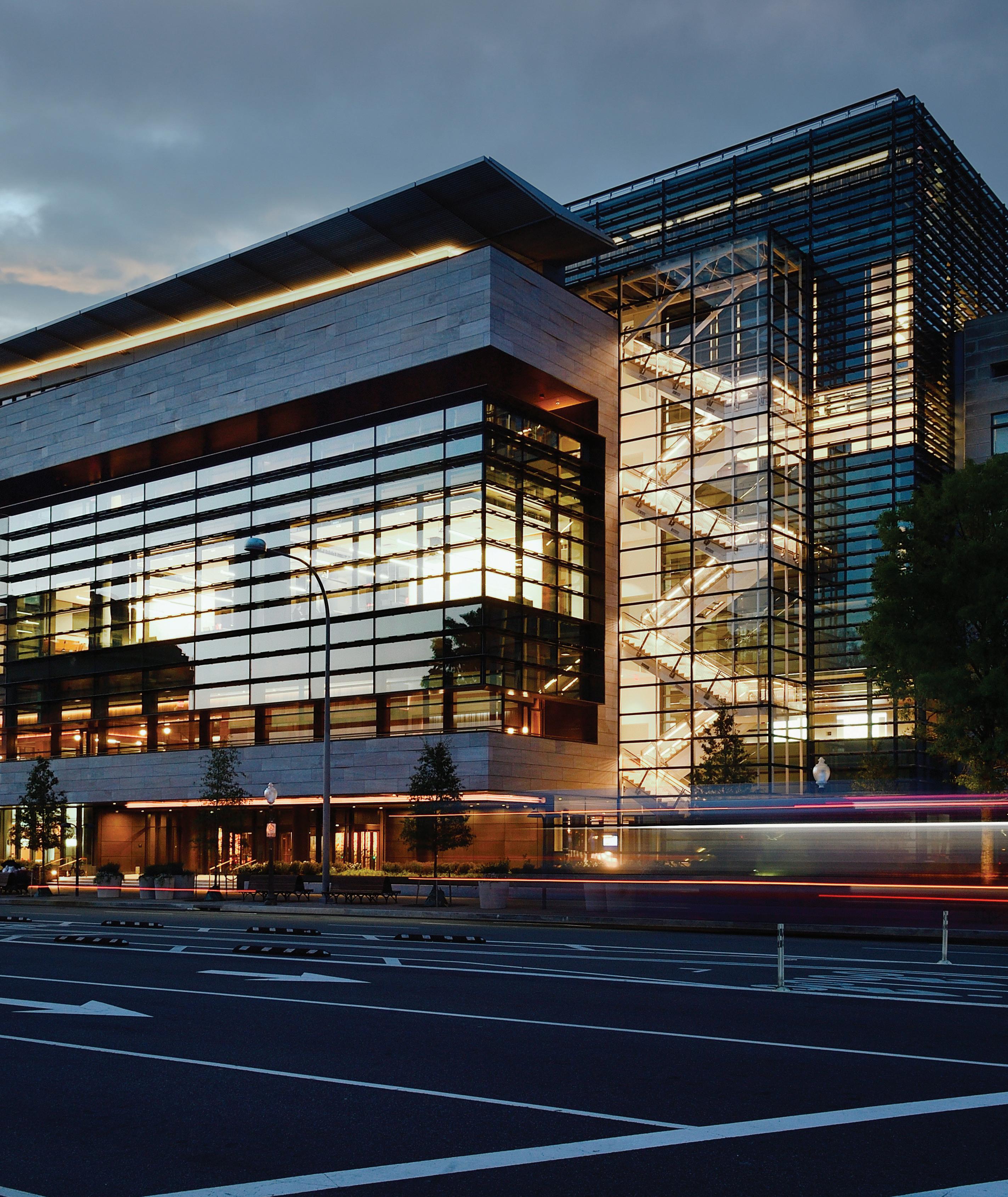
Will
16 Some prominent universities have expanded opportunities for their students by establishing campuses in the nation’s capital. ALSO INSIDE: Outdoor Learning 14 Performance Spaces 22 May/June 2024 asumag.com | schooldesigns.com
Photo:
Kirk



DON’T DO IT YOURSELF. Do it fully autonomously. karcher.com/us DO U

No matter your design vision, Roppe has the styles, profiles and colors to bring it to life. Our flooring, stair treads, wall base and accessories offer peak performance for education spaces, and our new colors provide a plethora of choices for design versatility. Our refreshed palette is in line with education design forecasts, from facilities for early learners through higher learning. The palette features a combination of familiar and timeless neutral tones with pops of vibrant color to spark creativity, stimulate learning and boost student success.
See how Roppe is Ready to support you, every step of the way.

For wherever your Design New colors. takes you. Scan to see all of the new colors.
roppe.com

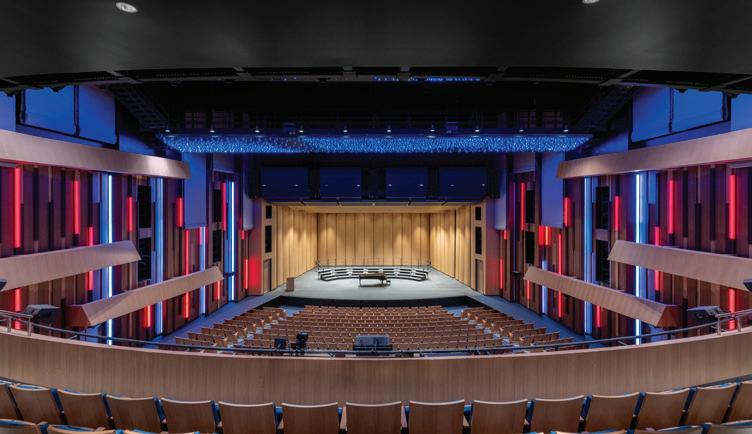
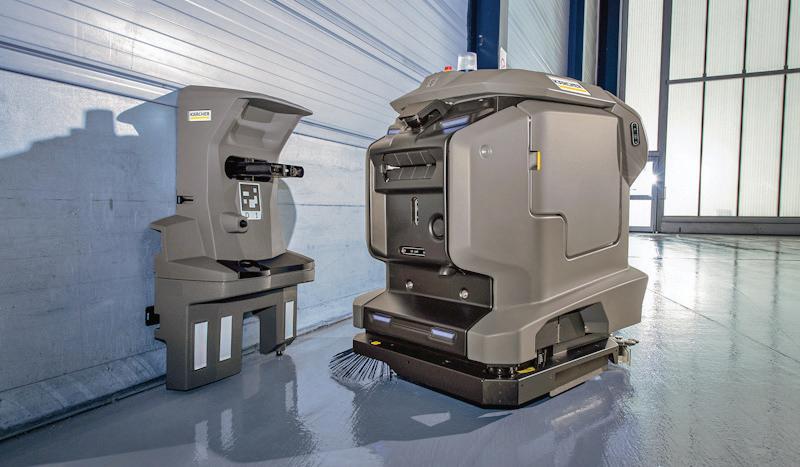

American School & University (USPS Permit 023-180, ISSN 0003-0945 print, ISSN 2161-7791 online) is published 7x a year (Jan/Feb, Mar/Apr, May/Jun, July, August, Sep/Oct, Nov/Dec) by Endeavor Business Media, LLC., 201 N. Main St., 5th Floor, Fort Atkinson, WI 53538. Periodicals postage paid at Fort Atkinson, WI, and additional mailing offices. POSTMASTER: Send address changes to American School & University, PO Box 3257, Northbrook, IL 60065-3257. SUBSCRIPTIONS: Publisher reserves the right to reject non-qualified subscriptions. Subscription prices: U.S. ($ 123.75); Canada/Mexico ($ 98.75); All other countries ($ 123.75). All subscriptions are payable in U.S. funds. Send subscription inquiries to American School & University, PO Box 3257, Northbrook, IL 60065-3257. Customer service can be reached toll-free at 877-382-9187 or at americanschool@omeda.com for magazine subscription assistance or questions. Printed in the USA. Copyright 2024 Endeavor Business Media, LLC. All rights reserved. No part of this publication may be reproduced or transmitted in any form or by any means, electronic or mechanical, including photocopies, recordings, or any information storage or retrieval system without permission from the publisher. Endeavor Business Media, LLC does not assume and hereby disclaims any liability to any person or company for any loss or damage caused by errors or omissions in the material herein, regardless of whether such errors result from negligence, accident, or any other cause whatsoever. The views and opinions in the articles herein are not to be taken as official expressions of the publishers, unless so stated. The publishers do not warrant either expressly or by implication, the factual accuracy of the articles herein, nor do they so warrant any views or opinions by the authors of said articles. TABLE OF CONTENTS CONTENTS VOLUME 96 • ISSUE 5 • MAY/JUNE 2024 DEPARTMENTS 10 Inside Flooring and Carpeting 12 Construction Zone Deferred Maintenance 14 Knowledge Center Outdoor Learning 34 Profiles People, Places and Goings-on VIEWPOINTS 26 Facility Planning Stakeholder involvement in planning and design FEATURES 22 Lasting Performance Schools are creating performing arts facilities that aim to enhance students’ career prospects. ALSO IN EVERY ISSUE ... 6 EDITOR’S FOCUS 8 ON THE WEB 28 PRODUCT SOLUTIONS 32 MARKET PLACE 33 AD INDEX 22 28 16 COVER STORY HIGHER
Goes to Washington Some prominent universities have expanded opportunities for their students by establishing campuses in the nation’s capital. 4 AMERICAN SCHOOL & UNIVERSITY • ASUMAG.COM • MAY/JUNE 2024
ED

Clean Restrooms Equal Healthier Schools.

Cleans in 1/3 the time of conventional cleaning methods
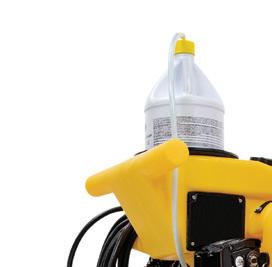



Up to 60X more efficient in removing bacteria from grout lines than mopping



Removes more than 99.9% of targeted bacteria when used with plain tap water only
ROI of 3 months or less in most cases
When it comes to restrooms and other heavily soiled areas, nothing beats KAIVAC® No-Touch Cleaning®. Built for extreme soil removal, No-Touch Cleaning empowers workers to clean hygienically without touching contaminated surfaces. Plus, it cuts labor, chemical, and equipment costs.

Call Kaivac today at 800-287-1136 or visit us at kaivac.com to learn more about No-Touch Cleaning.

Cellphone hangups
By Mike Kennedy
The latest chapter in the debate over student cellphone use in schools is taking place in Ohio, where Gov. Mike DeWine has signed legislation that aims to limit the use of the devices and curtail phone-related distractions in classrooms.
EDITORIAL
ADVISORY BOARD
Bruce Mather
Executive Director of Facilities Management
Elmhurst College, IL
Martin Montaño
Capital Projects Administrator
Rio Rancho Public Schools
Rio Rancho, NM
James E. Rydeen
FAIA, Armstrong Torseth
Skold and Rydeen, Inc.
Minneapolis, MN
DeWine says the schools have a responsibility “to safeguard our kids from the nonstop barrage of alerts from the internet and social media that have proven to be damaging to their mental health.” Some studies have cited links between cellphone use and cyberbullying and social isolation.
As someone who lived through the days when cellphones did not exist and the only phone in an entire school was in the principal’s office, I know that students from previous generations were able to survive and even thrive by relying on pencils, paper, textbooks and classroom discussions without outside intrusions.
But even an aging Baby Boomer like me is familiar with the concept of FOMO and understands the allure of instant access to information, even if it is just the latest pronouncement from a TikTok or Instagram influencer.
It may not be realistic for schools to try to rein in cellphone use at school when so many students have their own devices, and tablets, laptop computers and internet connections have

become an expected and essential part of 21stcentury instruction. And in an era when school violence is not unheard of, many parents feel less apprehensive about their children’s safety when a student has a cellphone and can text or call a parent immediately in the event of an emergency.
Those who see technology as a valuable learning tool that enhances education have argued that instead of prohibiting cellphones and creating an adversarial relationship with students, schools should focus on teaching students how to use cellphones responsibly. The benefits—virtually unlimited access to research and other resources that enhance classroom instruction, the ability for cellphone users to personalize their learning—may outweigh the downsides.
I lean toward that view, but it’s an easy position to take from the sidelines as a magazine editor. A few days managing a classroom full of distractible students might convince me that Ohio has the right idea.

Enter Architectural Portfolio 2024
This summer, American School & University magazine will assemble a panel of education and architectural professionals to judge the 42nd annual Architectural Portfolio, the industry’s most recognized awards program for education design excellence.
Selected projects will be published in the 2024 Architectural Portfolio issue this November—showcasing the best in education design. We invite you to include your latest outstanding education facility.
Visit https://schooldesigns.com/architectural-portfolio to enter or for more information about the competition and 2024 entry benefits.





■ editor's focus
6 AMERICAN SCHOOL & UNIVERSITY • ASUMAG.COM • MAY/JUNE 2024
Senior Editor Mike Kennedy has written for AS&U on a wide range of educational issues since 1999.





































From the world’s #1 air conditioning company, discover the cloud connected benefits of VRV EMERION provided by Daikin’s HERO Cloud Services.

DISCOVER MORE AT: WWW.VRVEMERION.COM
2024 . CONNECTED S .
www.asumag.com www.schooldesigns.com
CONTENT DIRECTOR/ ASSOCIATE PUBLISHER
Joe Agron • jagron@endeavorb2b.com
SENIOR EDITOR
Mike Kennedy • mkennedy@asumag.com
ART DIRECTOR
Julie Whitty • jwhitty@endeavorb2b.com
AWARD PROGRAM MANAGER
Heather Buzzard • hbuzzard@endeavorb2b.com
EDITORIAL CONTRIBUTORS
Stephen Ashkin; Paul Erickson; American Institute of Architects Committee on Architecture for Education
VP/MARKET LEADER— BUILDINGS & CONSTRUCTION
Mike Hellmann • mhellmann@endeavorb2b.com
GROUP EDITORIAL DIRECTOR— BUILDINGS & CONSTRUCTION GROUP
Mike Eby • meby@endeavorb2b.com
SENIOR PRODUCTION OPERATIONS MANAGER
Greg Araujo • garaujo@endeavorb2b.com
PRODUCTION MANAGER
Brenda Wiley • bwiley@endeavorb2b.com
ENDEAVOR BUSINESS MEDIA, LLC
CEO | Chris Ferrell
President | June Griffin
COO | Patrick Rains
CRO | Reggie Lawrence
Chief Digital Officer | Jacquie Niemiec
Chief Administrative and Legal Officer Tracy Kane
EVP, Buildings, Lighting, & Digital Infrastructure Tracy Smith
SUBSCRIPTION CUSTOMER SERVICE: (847) 559-7598 americanschool@omeda.com
Wisconsin college says it will stay open, get smaller

An eleventh-hour fundraising effort has helped Northland College in Ashland, Wisconsin, stave off closing.
The Milwaukee Journal Sentinel reports that the school will keep its doors open in the fall by embracing a smaller model with fewer majors.
The decision to remain open comes weeks after Northland announced a last-ditch fundraising campaign to keep the school open in 2024-25.
The fundraising drive yielded $2 million to cover this school year’s budget deficit and more than $4 million for next year’s.
The college will also “right-size” its employee base to save $7 million. College President Chad Dayton said it was too early to say how many of the roughly 45 faculty and 80 staff will lose their job.
Under the new model, Northland will offer eight majors, including business, biology, education, psychology and four programs associated with the environment. That’s down from the 29 majors now offered. https://asumag.com/55036905
Parents of Michigan high school shooter sentenced to 10 to 15 years in prison
AMichigan judge has sentenced James and Jennifer Crumbley to 10 to 15 years in prison each for their roles in a 2021 fatal high school shooting carried out by their son.
The Detroit Free Press reports that the Crumbleys are the first parents in the United States to be held criminally responsible in a mass shooting committed by their child. Ethan Crumbley was 15 and a sophomore at Oxford High School in Oxford, Michigan, in November 2021 when he brought a gun to school and fatally shot four students. Another seven people were injured.


prison. Killed in the attack were Tate Myre, 16; Hana St. Juliana, 14; Madisyn Baldwin, 17; and Justin Shilling, 17. Oakland County Circuit Court Judge Cheryl Matthews said the parents’ criminal convictions stemmed from repeated acts of ignoring their son’s troubles.
Ethan’s father bought a handgun as an early Christmas present and set the stage just four days before the shooting attack, prosecutors said.


CORPORATE OFFICE:
Endeavor Business Media
30 Burton Hills Blvd. , Ste 185 Nashville, TN 37215 (800) 547–7377 endeavorbusinessmedia.com
Separate juries convicted each parent earlier this year of four counts of involuntary manslaughter. Ethan Crumbley pleaded guilty in 2022 to murder and other charges and has been sentenced to life in

The parents have maintained that they saw no signs that their son would hurt anyone or was mentally ill, that they did not know of his plan to shoot up the school and that the gun was not a gift or his to freely use.
https://asumag.com/55016918
Book banning in schools surges, report says
The number of individual books banned by schools has soared to a record level, according to a PEN America report, Banned in the USA: Narrating the Crisis.
The report documents over 4,000 instances of book banning during the first half of the 2023-24 school year—more than in the entire previous 2022-2023 school year.
The report, which examined book bans from July to December 2023, details book bans in 52 public school districts across 23 states. Bans took place in both red and blue districts.
PEN America is a nonprofit organization that works to defend free expression.
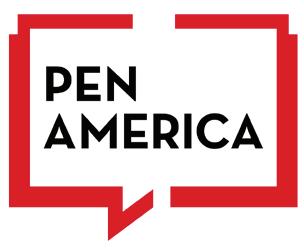
The report examines a wave of intense scrutiny over books that discuss women, sexual violence, and rape. The report also finds that books discussing race and racism, LGBTQ+ and transgender identities continue to be targeted at consistently high rates.
Among states, Florida had the highest number of reported bans: 3,135 bans across 11 school districts.
https://asumag.com/55019032
Former assistant principal charged in connection with 2023 shooting of teacher by 6-year-old student
T he former assistant principal of a Newport News, Virginia, elementary school where a 6-year-old shot his teacher faces child abuse charges.
ABC News reports that Ebony Parker was charged with eight counts of felony child abuse in connection with the January 2023 shooting, which left first-grade teacher Abby Zwerner wounded.
Parker resigned from her position at Richneck Elementary School shortly after the shooting.
The grand jury indictment accuses Parker of failing to act on warnings that the boy had a gun in school that day.
The indictment charges Parker with eight counts - “one count for each of the eight bullets that endangered all the students in Ms. Abigail Zwerner’s first grade classroom,” the Newport News Commonwealth’s Attorney’s Office said in a news release.
https://asumag.com/55017612

■ on the web | asumag.com
8 AMERICAN SCHOOL & UNIVERSITY • ASUMAG.COM • MAY/JUNE 2024
Oakland County Sheriff’s Office Northland College







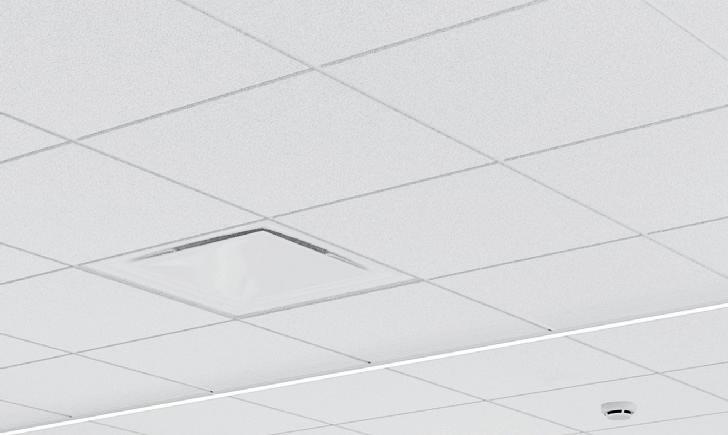











Ceilings designed to save energy

Saves up to 15% energy
Aids in carbon reduction
Templok® Energy Saving Ceilings can reduce your school’s HVAC energy costs and consumption up to 15%* and enhance thermal comfort with advanced Phase Change Material technology. The panels deliver Total Acoustics® performance for the highest sound blocking and sound absorption. Start saving today at armstrongceilings.com/energysavingceilings
*Measured cooling energy savings in lab test. Results may vary. See Templok Technical Guide for details.
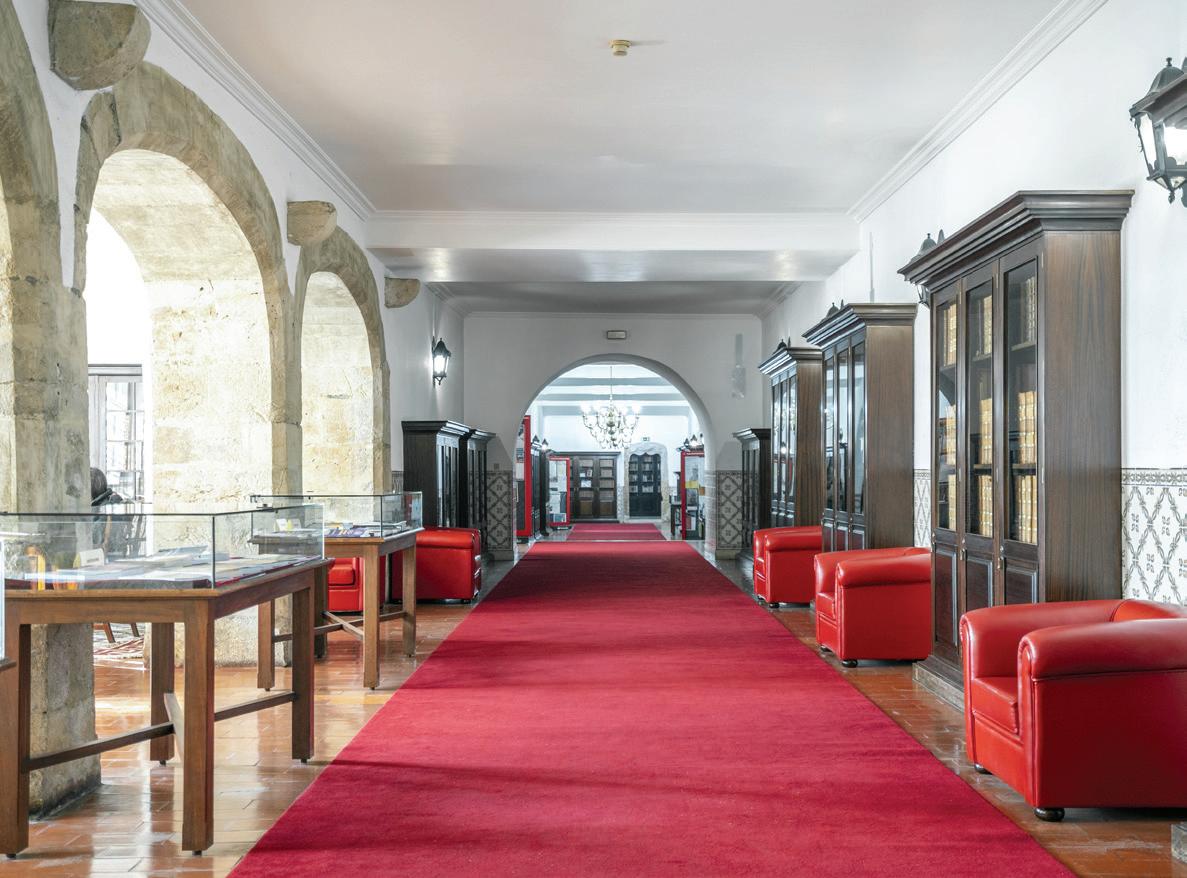
Safer and Healthier
Carpeting? Resilient flooring? When choosing what to install in their facilities, schools and universities typically weigh the advantages and disadvantages that come with each flooring type and consider the function of a particular space and who will be spending time there.
But whether facility managers opt for carpet or resilient flooring, they should be careful to avoid carpet and flooring products that contain potentially harmful substances. To help them do so, the Center for Environmental Health (CEH), which works to reduce exposure to toxic chemicals, has partnered with Health Care Without Harm to make it easier for managers of education institutions and other facilities to select the safest carpet and resilient flooring.
Here are the CEH’s “10 Reasons to Choose Healthier Carpet and Resilient Flooring.”
1. Some carpet and flooring may be a significant source of exposure to chemicals that are associated with a range of health issues, including asthma, cancer, diabetes, immune system disorders, and reproductive and developmental harm. Health problems linked to chemical exposure are on the rise. CEH guidelines restrict the use of harmful substances—including vinyl, PFAS, bisphenols and flame-retardant chemicals—associated with these and other conditions.
2. Conventional carpet and flooring products can release volatile organic compounds (VOCs), which have been found to impair cognition. A recent study found that in a setting with average VOC levels, people had significantly diminished cognitive functions compared with working in a setting with increased ventilation and reduced VOC levels. In the improved indoor environment, participants scored substantially higher on cognition tests that measured functions including crisis response, information usage and strategy, among others. CEH guidelines restrict VOC emissions and require products to meet the highest standards for indoor air quality.
3. Indoor air can be two to five times more polluted than outdoor air, and people in the United States spend about 87% of their time indoors. Crises like COVID-19 and wildfires have forced people to spend more time indoors. Try to avoid products in schools that can adversely affect people’s immune systems and exacerbate the health effects of these crises.
4. People are demanding safer, healthier, and more sustainable work and living environments. A recent study found that 90% of millennials, who make up the largest share of the workforce, say that working in a sustainable workplace was important to them. A commitment to healthier products will help organizations attract and retain employees and protect the health and wellbeing of those who work in or visit a space.
5. Selecting healthier carpet and resilient flooring products can help organizations earn sustainability credits. Examples of credits that the products on the CEH list contribute to include LEEDv4 (several categories), International WELL Building Institute’s v2 X05 (Enhanced Material Restrictions) and X08 (Materials Optimization), and Living Building Challenge v4 Imperative (Responsible Materials) and Imperative (Red List).
6. Toxic materials in carpet and flooring endanger health across the product life cycle. People involved in the manufacturing, maintenance, and disposal of these products— and those who live in communities where the chemicals are produced and disposed of—are adversely affected, as are air, water, soil, and wildlife. For example, PVC flooring may have a significant carbon footprint, and if it burns, it may release cancer-causing dioxins and furans.
7. Products on the CEH list typically require less maintenance than conventional products. Some of the products used to clean and maintain carpet and flooring can harm the health of cleaning and maintenance workers, and the environment. The products that meet CEH specifications don’t require these harmful treatments. For example, the resilient flooring products that meet CEH criteria don’t require the stripping, sealing, waxing, and finishing needed for conventional resilient floors. Many of the healthier products come in tile or plank formats, allowing for replacement of pieces that become damaged rather than re-carpeting or flooring the whole area.
8. Buying healthier products diverts harmful waste from landfills. In the United States, about 2 million tons of carpet is sent to landfills every year, where toxic chemicals can leach into the soil and groundwater. Unlike most conventional carpet products, the ones that meet CEH specifications must have manufacturer-offered take-back programs.
9. Safer, healthier products are available. Resilient flooring and carpet products that meet CEH criteria can be found on The Greenhealth Approved website (https://greenhealthapproved.org/greenhealth-approved-products).
10. An organization’s purchasing power can help shift the market toward safer products for everyone. Selecting products with better health and safety profiles sends a message to manufacturers that purchasers don’t want hazardous chemicals in their products, thereby growing the market for safer products. Increased demand can lead to wider availability and a broader range of healthier products.

167698308 © Golasza | Dreamstime.com ■ inside | flooring and carpeting
10 AMERICAN SCHOOL & UNIVERSITY • ASUMAG.COM • MAY/JUNE 2024

Improving IAQ has NEVER BEEN SMARTER.
For today’s schools, indoor air quality can go a long way in impacting student health and performance. That’s why Carrier offers a full portfolio of solutions to help schools optimize learning environments with students, staff and sustainability in mind.
• Rooftop Units
• Air Handlers
• Chillers
• Variable Refrigerant Flow (VRF) Systems
• Building Automation and Controls
• Air Purifiers and Filters
• Service and Replacement Parts
• Equipment Rentals
From design to ongoing maintenance, Carrier will work with you to customize a solution to fit your school’s unique needs. Connect with us today to create better spaces for learning – and a better future for your students, staff and planet.
Count on Carrier to help you optimize the health, safety and performance of your school with confidence.
Visit carrier.com/k-12 to get started.
Carrier. All Rights
©2024
Reserved.
$1.5 billion earmarked for school facility upgrades in Idaho

The state of Idaho has agreed to spend an additional $1.5 billion over the next decade to help schools pay for badly needed upgrades of school facilities.
The legislature acted to address the state’s long history of failing to provide adequate funding for maintaining schools. The legislation signed by Gov. Brad Little allocates $150 million a year to school districts for 10 years.
The Idaho Statesman and ProPublica have reported extensively on how the state’s reluctance to invest significantly in school facilities has led to students learning in schools with failing heating systems, leaking roofs, discolored drinking water and overcrowded classrooms.
A 2022 report from the state’s Office of Performance Evaluations pointed to Idaho’s failure to provide school districts with adequate funding for school facility maintenance.
“Idaho ranks near the bottom nationally for funding school building maintenance, both on a per-student and per-building gross square footage basis,” the report said.
The report also noted that Idaho had not conducted a statewide facility condition of school buidlngs since 1993.
Report says Indian Affairs is failing to effectively manage deferred maintenance in schools
Afederal report has concluded that Indian Affairs is unable to effectively manage deferred maintenance of the school facilities it operates

The report from the Office of Inspector General for the U.S. Department of the Interior said that the management failures stem from “funding delays, processing work orders based on a monetary threshold, limited project management capacity and unreliable work order data.”
Indian Affairs, in collaboration with the Bureau of Indian Affairs and the Bureau of Indian Education, manages 183 elementary and secondary schools and other education facilities.
“As of September 2022, [Indian Affairs] reported that it would
cost more than $1 billion to address its deferred maintenance at school facilities,” the report says.
Contributing to the delays in carrying out maintenance jobs is the practice of processing work orders as deferred maintenance rather than operations and maintenance (O&M).
“While school facility staff can immediately address O&M work, deferred maintenance work orders require a more timeintensive funding and approval process that must go through multiple layers of approval,” the report says. “Further, we identified approved deferred maintenance work orders that, even 22 years after approval, were still not funded.”
Poway (California) district has $185 million in deferred maintenance
An assessment of the Poway (California) Unified School District’s aging buildings reported that an estimated $185 million in deferred maintenance is needed to maintain the existing facilities

The San Diego Union-Tribune reports that the cost estimate came from an assessment by Ameresco Asset Sustainability Group. The size of the deferred maintenance backlog had nearly doubled from the firm’s 2019 estimate of $94.7 million.
About 68% of the district’s deferred maintenance is described as urgent or high priority, the report says.
The 36,000-student district has 770 buildings at 41 sites, with a combined 4.15 million gross square feet, said Rheia Alschbach, Poway’s director of capital planning. The average age of the district’s buildings is over 32 years.
In recent years, the district has had to repair leaky roofs, failing air conditioning, outdated plumbing and aging locker rooms, Alschbach said.
The district now budgets about $1 million per year for deferred maintenance, but based on the Ameresco report, an estimated $38.5 million would be needed each year during the next 30 years to maintain facility conditions at the current “fair” level, said Marc Retish of the Ameresco firm.


■ construction zone | deferred maintenance
12 AMERICAN SCHOOL & UNIVERSITY • ASUMAG.COM • MAY/JUNE 2024
Photo 165607588 © Achisatha Khamsuwan | Dreamstime.com


Bradley’s cast-formed TLX Series Express ® lavatory system is now available in a one-piece, 4-station model. A seamless, complete handwashing package that maximizes value and hygiene, and delivers long lasting performance. Commercial Washrooms. Brought to Life. Economical Repairable Seamless Easy to Install Easy to Clean bradleycorp.com/express-lavatory-systems 4-Stations x4
HANDWASHING POWERHOUSE
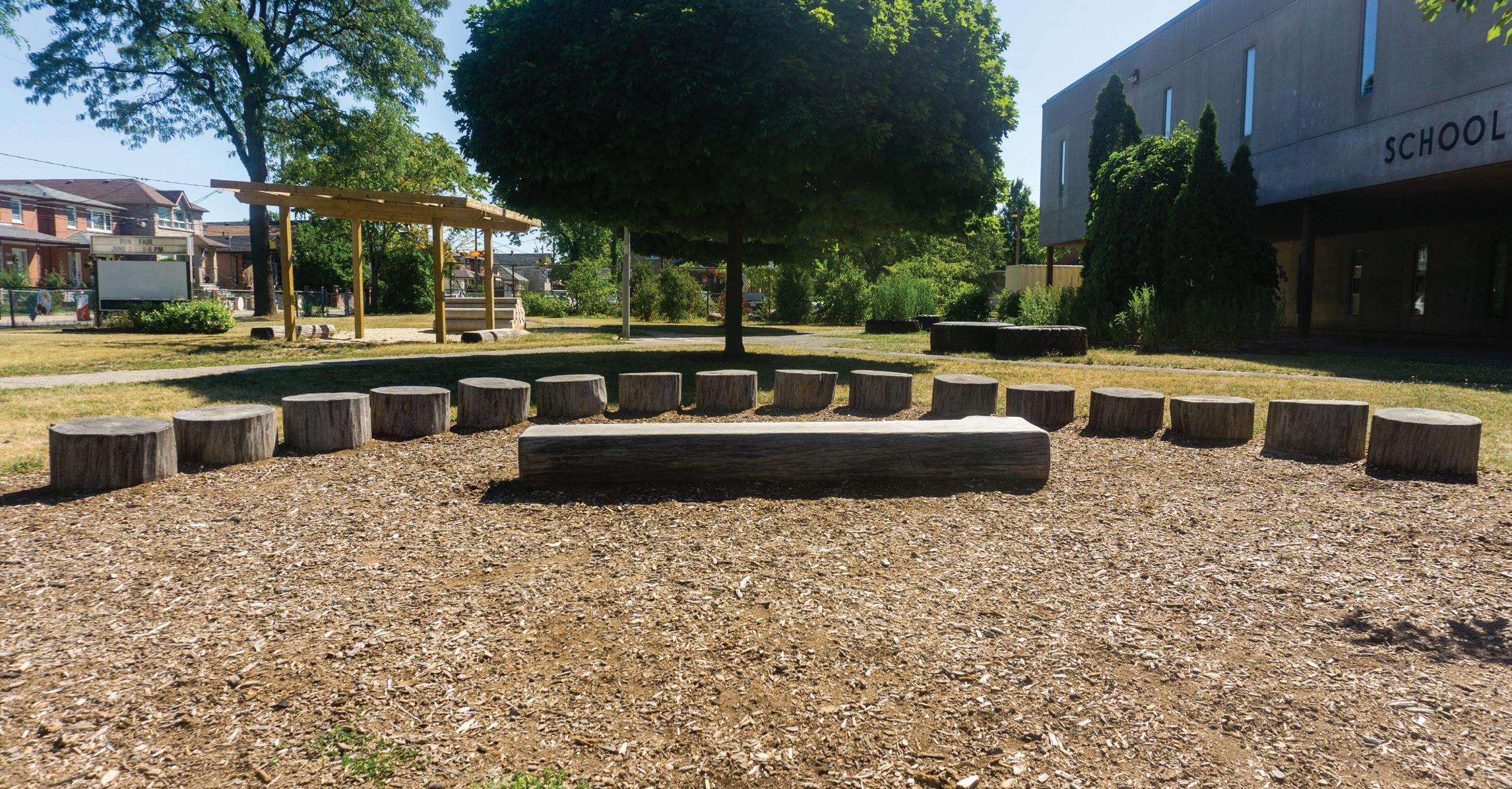
The Covid-19 pandemic prompted many schools to move some of their classes outdoors.
A FRESH PERSPECTIVE
What kinds of seating and work surfaces should schools have in outdoor learning spaces?
by Mike Kennedy
Outdoor learning spaces, especially in regions of the country with warm climates, have been an important element of school campuses for many years, but their value has become more recognized as educators responded to the Covid-19 pandemic by pivoting to safer ways of delivering instruction.
Students were at greater risk of contracting Covid-19 indoors, so the avail-
Low or no cost
Use existing seating Many campuses have existing seating areas—lawns, picnic tables, bleachers, built-in amphitheaters, and concrete walls. This seating can be easily adapted to accommodate physical distancing.
Reconfigure existing seating. Gather existing picnic tables or other types of seating already on campus and move them to a central location to organize them as classrooms that incorporate physical distancing.
Straw bales. Straw bales are about 36 inches long and 18 inches wide and can seat one student each. If allergies, scratchy surfaces, or insects are a concern, assign each student a large rectangle of outdoor fabric to lay over the bale, or give each student a seat cushion to place on the bale.
Logs and stumps. Local arborists and park managers who remove trees that fall after a storm often have access to logs that can be repurposed as seating for outdoor learning.
Low-cost portable
Move indoor furniture outdoors. Classroom desks, tables, and chairs can be moved outdoors for an individual instructional period or an entire day. Most indoor furniture will need to be moved back inside at the end of each day unless it is placed in a sheltered location.
Buy outdoor seating. Many types of low-cost outdoor chairs, stools, and cushions are available, such
ability of outdoor areas with freely circulating fresh air not only offered a less risky learning environnment that had the desired physical distancing but also provided a change of pace that could spark student engagement.
Most schools can lay claim to some space outside the walls of their buildings, but what should an outdoor learning space consist of?
as lawn, beach, and camping chairs. A pouch can be placed on the backs of chairs to hold folders, notebooks, and papers.
Use picnic blankets. Blankets are a comfortable option for short periods of outdoor instruction.
Buy mats. Small mats made from plastic or rubber are easy to clean between uses. Examples include kindergarten mats, yoga mats cut in half, stadium cushions, or rubber play tiles.
Buy crates and 5-gallon buckets. Plastic crates or 5-gallon buckets with lids are very portable and make durable, movable seats. They can double as both seating and a vessel to carry supplies.
Moderate investment
Buy or build picnic tables. Designs can include bench seating on two sides of a table, one bench whose back folds down into a table, or tables in the shape of a square, hexagon, or circle.
Build benches. Benches can be built from recycled materials and from untreated lumber cut from weatherproof woods such as cedar or redwood. Benches can be secured with concrete footings or similar techniques to minimize protrusions and vandalism.
Add rocks and boulders. Stones make attractive, interesting, and long-lasting outdoor seating. Schools can partner with local quarries or businesses that sell stone to find boulders that meet bench height requirements for students.
Green Schoolyards America, an advocate for outdoor school classrooms and a leader in the National Covid-19 Outdoor Learning Initiative, has recommendations for the kinds of seating and work surfaces that should be part of a school’s outdoor space. The recommendations encompass four categories: low and no cost; low-cost portable solutions; moderate investment; and larger capital investment.
Larger capital investment
Install permanent benches and seats. Permanent seating can be handmade or commercially produced from a variety of materials such as carved wood, mosaic on concrete, or metal.
Create council rings. These outdoor gathering spaces are typically made from stone or wood benches arranged in a circle. Circular benches allow for conversation and collaboration.
Construct amphitheaters. Amphitheater seating can be built into existing or constructed slopes and surfaced with grass, inset logs, or benches made from stone or other materials.
Other considerations
Access. Seating areas should not block emergency access or impede safety on a school campus.
Topography. Place seating on a flat or gently sloped area to ensure that it is accessible.
Flexibility. Consider active seating options that enable students to change position as needed and sit upright, recline, curl up, stretch out, or stand. Comfort. Unpadded seating is comfortable enough for short periods. For longer periods, consider softer, padded seating and incorporate breaks.
Work surfaces. In addition to seating, students may need work surfaces. These surfaces can be portable (e.g., clipboards, lap desks) or permanent (e.g., tables, individual desks).




14 AMERICAN SCHOOL & UNIVERSITY • ASUMAG.COM • MAY/JUNE 2024 ■ knowledge center | outdoor learning
100416464 © Mconrad85 | Dreamstime.com












16 AMERICAN SCHOOL & UNIVERSITY • ASUMAG.COM • MAY/JUNE 2024 ■ cover story | facilities
Some prominent universities have expanded opportunities for their students by establishing campuses in the nation’s capital.
By Mike Kennedy
Southern California evokes images of sunshine, palm trees and beaches. But that’s not the vibe at the newest campus of the University of Southern California. A continent away from surfboards and the sands of the Pacific Ocean, USC’s Capital Campus in Washington, D.C., which opened last year, is more focused on the ebb and flow of politics and government policy.
USC is one of several universities that have been claiming space close to the levers of power in the nation’s capital. The city is home to several prestigious universities—Georgetown, George Washington, Howard, and American to name a few—but many other higher education institutions have a local presence. The District of Columbia’s Higher Education Licensure Commission lists more than 100 schools with degree programs that are approved to operate in Washington, D.C.
Having programs or more substantial satellite campuses in Washington, D.C. enables those schools to give students more opportunities to observe government in action and interact with researchers and policymakers. And for those drawn toward careers in the public sector, the hands-on experience among the movers and shakers in the nation’s capital gives them a leg up.
Of the universities that have recently expanded their Washington, D.C., footprint, the ones making the biggest splash are Johns Hopkins University and the University of Southern California. Each of those institutions has taken advantage of existing office space available for sale and invested mil-

lions of dollars to establish a significant satellite campus that announces their intention to be more active participants in the nation’s public policy and research discussions.
Museum makeover
Johns Hopkins University’s main campus in Baltimore is close to Washington, D.C.—only about 40 miles north—but the university desired to be a bigger player in the political and governmental activities in the nation’s capital.
Its quest for a more visible presence in Washington coincided with the decline and eventual demise of another city attraction—the Newseum, a $450 million museum dedicated to journalism that opened in 2008 on Pennsylvania Avenue between the White House and the U.S. Capitol. The Newseum shut down at the end of 2019, and Johns Hopkins stepped forward to acquire the facility for $372.5 million. Then it ponied up an additional $275 million to renovate the former museum and convert it to an education facility.
The result is the Johns Hopkins University Bloomberg Center at 555 Pennsylvania Ave. It officially opened in October 2023.

The 435,000-square-foot facility houses the School of Advanced International Studies, Carey Business School, the Krieger School of Arts and Sciences, Peabody Institute, and the newly established School of Government and Policy.
The 10-story steel and glass building features 38 high-tech classrooms, the university says. Other amenities include a lounge-style library; a multimedia studio; 435 seats available for informal study; 26 enclosed study rooms; a 375-seat theater with sound-absorbing walls for music performances and a sprung stage for dance; an art gallery; three floors of conference center space; a banquet hall; a fitness and wellness center; and landscaped roof terraces.
“The Hopkins Bloomberg Center’s design embodies its purpose—a single, dynamic space that brings together all the university’s divisions, offering opportunities for collaboration and innovation on significant policy issues to better serve the nation and the world,” said Johns Hopkins University President Ronald J. Daniels.
Ennead Architects designed the renovations of the former museum in collaboration with Rockwell Group and SmithGroup. The updates simplified and reorganized the Newseum’s building plan. The museum was designed to accommodate highly specialized exhibits; the revised design reconfigures the floorplates to increase the building’s square
ASUMAG.COM • AMERICAN SCHOOL & UNIVERSITY 17
Programs housed in the Johns Hopkins University Bloomberg Center include include the School of Advanced International Studies, the Carey Business School, the School of Nursing, and the Krieger School of Arts and Sciences’ Advanced Academic Programs.
Photo by Will Kirk






footage and modifies building systems to support Johns Hopkins’ programs and sustainability goals.
Go East
Spurred by the rallying cry “Go West,” thousands of pioneers traversed the continent in the 1800s and eventually arrived in California.
But for students and faculty at the University of Southern California’s new Capital Campus in Washington, D.C., it’s a bit of a reverse commute—more than 2,600 miles to the east.
USC bought the 60,000-square-foot building at 1771 N St. NW for $49.4 million in 2023. The facility previously housed the headquarters for the National Association of Broadcasters. USC’s sizeable presence in the heart of the city provides an East Coast anchor for the prominent West Coast institution.
Officials say the Capital Campus puts the university at the center of global political and policy discussions and will serve as
DURABILITY Designer

Protect-All Designer Series® flooring withstands the abuse of heavy use without showing wear. Its safe, slip-resistant surface repels microbes, chemicals, fire, and odors. Made from over 90 percent recycled material, it’s easy on the eye, and the environment. Featuring a solid base color with varying accent colors throughout, this unique flooring can withstand high-traffic areas while enhancing the design of any space.



Enhance the aesthetics and performance of your next flooring project. Visit protect-allflooring.com or call 800.544.9538


OP Protect-All Designer Series Ad - OP040006 Org:11 30 20 REV: 10 6 21 “Protect-All” and “Protect-All Designer Series” are registered trademarks owned by Oscoda Plastics, Inc Heavy-duty can now be stunning
d d MEETS BLACK
2306ASU_ProtectAllFlooring.indd 1 5/24/23 12:42 PM 18 AMERICAN SCHOOL & UNIVERSITY • ASUMAG.COM • MAY/JUNE 2024 ■ cover story | facilities
BASE
USC’s Capital Campus in Washington, D.C.
Alan Karchmer
the university’s link to nearby embassies and diplomatic outposts.
“We believe that a city like Washington, D.C., with a vibrant mix of government, the arts, public policy organizations, research agencies and foundations is ideal for our expanded presence,” says Brian K. Wilson, director of USC Real Estate and Development.
The university had been leasing space in two buildings in downtown Washington and had been looking at several possible sites for the Capital Campus when it became aware of 1771 N Street NW, Wilson said.
“We did not consider constructing a new building given the high cost to do so and the relatively low pricing for existing

buildings,” Wilson says. “1771 N Street NW had been recently renovated and was available at an attractive price.”
Before the building was purchased by USC, the HOK architecture firm designed an extensive renovation that included a six-story glass façade, rejuvenated outdoor spaces and interior improvements.
HOK says the renovation received a LEED
Gold certification and reduces the building’s energy and water use by 35%.
It has modern office space, multiple event venues and an outdoor terrace offering panoramic views of the city skyline. It also will house the USC Office of Research Advancement, which helps faculty researchers secure federal funding for research projects.


MAY/JUNE 2024 • ASUMAG.COM • AMERICAN SCHOOL & UNIVERSITY 19 WATCH WITHOUT LIMITS A MORRIS GROUP INTERNATIONAL MOVIE Find Your Lifestyle at murdockmfg.com Murdock® Water Coolers and Bottle Fillers offer the perfect combination to keep kids hydrated in school. By installing an A172 Series bi-level water cooler with an H2O-to-Go!® Bottle Filler, schools can save as many as 4000 plastic bottles per month! Keeping Kids Hydrated and Focused on Their EducationSince 1853 (800) 591-9081 • SALES@MURDOCKMFG.COM • WWW.MURDOCKMFG.COM 2406ASU_MorrisGroupInternational.indd 1 5/8/24 2:57 PM

Planting a flag in D.C.
Here are some of the other universities that have put down stakes in the nation’s capital:
Texas A&M University: The Bush School of Government and Public Service was founded in 1997 on the College Station campus. Named for former President George H.W. Bush, the school offers graduate programs such as Public Service and Administration, International Affairs, and International Policy, so it made sense when the school decided to expand to Washington, D.C., in 2021.
Its location at 1620 L St. NW has almost 47,000 square feet of space across five floors, and is just a few blocks from the White House and other key governmental agencies.
“This enables Bush School students to study near the most prominent members of the national security community, including the FBI, CIA, NSA, State Department and Pentagon, and think tanks,” the Bush School’s website says.
The space has classrooms, conference rooms, study lounges, and collaborative/ huddle rooms; an admissions center, catering kitchen, snack and beverage stations, and a 150-seat theater/lecture hall.
Arizona State University: The university opened its flagship Washington, D.C., facility—the ASU Barbara Barrett and Sandra Day O’Connor Washington Center—in 2018. The building, a converted apartment building, expanded ASU’s presence in the nation’s capital, and provides additional learning, teaching and research opportunities for students and faculty members.
The center houses the Washington Bureau of the Walter Cronkite School of Journalism and Mass Communication, the Sandra Day O’Connor College of Law Rule of Law and Security program, the Capital Scholars program, and the McCain Institute’s Global Leaders program, among others.
Princeton University: The Princeton School of Public and International Affairs leased a Washington, D.C., location in 2023 to provide students and faculty with a closer connection to policymakers.
The school’s site at 1333 New Hampshire Ave. NW has more than 6,700 square feet of office space: a conference room, offices, a reception area, and a pantry/ kitchen, and an open area of 600-plus square feet for gatherings. The building also has a rooftop area with views of downtown Washington, and indoor and outdoor spaces that can accommodate almost 490 people for larger events.
USC’s Capital Campus in Washington, D.C., includes an outdoor terrace that provides views of the city skyline.
This year, USC announced the first major research and education facility to be headquartered at the Capital Campus. It has established the USC Leonard D. Schaeffer Institute for Public Policy & Government Service.
The institute represents an expansion of two programs—the USC Schaeffer Center for Health Policy & Economics and the Leonard D. Schaeffer Fellows in Government Service. A $59 million donation from Leonard D. Schaeffer and his wife, Pamela, will pay for a build-out of the seventh floor of the Capital Campus, which be dedicated to the Schaeffer Institute. The institute also will have offices on the USC campus in Los Angeles.
Having the institute in Washington, D.C., will enable scholars to more easily and frequently share fact-based policy solutions with public- and private-sector leaders, the university says.
“The Schaeffer Institute will be an invaluable resource for education and scholarship, not just for Schaeffer scholars and its affiliated experts but for faculty members and students from multiple disciplines across USC,” says Dana Goldman, dean of USC Sol Price School of Public Policy and co-director of the USC Schaeffer Center. “Their ability to use our Capital Campus office to more easily engage with policymakers will give them far more impact.”
Mike Kennedy (mkennedy@asumag.com) is senior editor of AS&U.
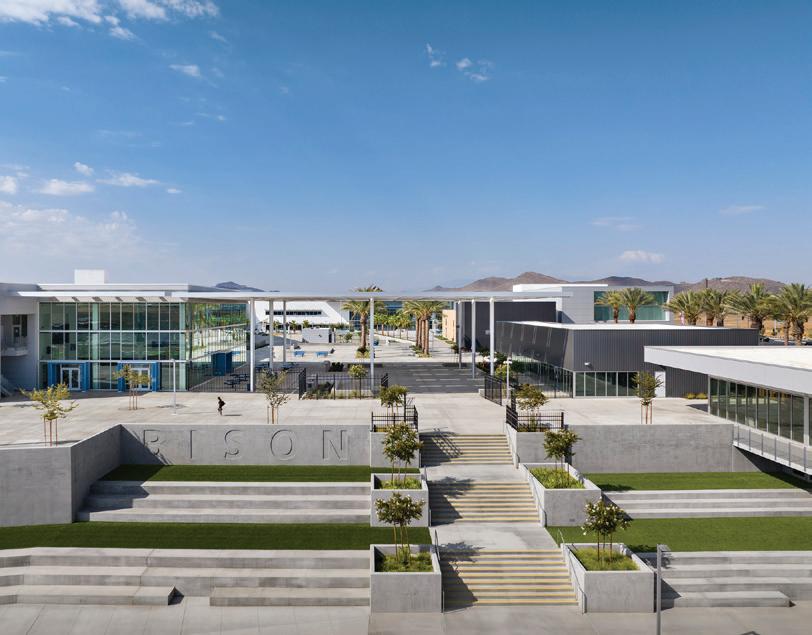

20 AMERICAN SCHOOL & UNIVERSITY • ASUMAG.COM • MAY/JUNE 2024 ■ cover story | facilities
Alan Karchmer
Entry Forms Due: June 14
Portfolios Due: July 26






2024 Call for Entries
Entry Forms Due June 14. Portfolios Due July 26.
• Discounts for multiple projects and multiple pages.
• Open to projects completed since January 1, 2019.
• Entry categories for pre-K through higher-education. New construction, renovation, and work in progress.
• Featured in the fall 2024 Architectural Portfolio issue, full-screen galleries on SchoolDesigns, and our e-newsletter.
• Larger circulation, including expanded reach to school boards and industry event partners.
• National recognition for you, your project, and the school or university.
• Free print-ready PDF for multiple entries and multi-page projects. Contact Heather Buzzard at hbuzzard@endeavorb2b.com or visit SchoolDesigns.com to enter today.
Presented by
1. Liberty High School-Firm-DLR Group-Photo Credit-Zack Benson; 2. Jackson Prep Lower School-Firm-Ferguson and Associates Architecture- Photo Credit- Sully Clemmer Photography; 3. Ty Willimas Memorial Pavilion-Firm-Design Development Architects Photo Credit- Design Development Architects; (middle row) 4. The Parr Center- Firm-Moody Nolan-Photo Credit Mark Herboth 5. Cornell College Richard and Norma Small Athletic and Wellness Center-Firm- Kahler Slater-Photo Credit- Peter McCullough; 6. Gwinnett Technical College-Firm-Sizemore Group- Photo Credit- Dorian Shy, Framework Photographic. FORTY-SECOND ANNUAL
Photo credits: (top row from left to right)

LASTING PERFORMANCE
Schools are creating performing arts facilities that aim to enhance students’ career prospects.
by Brandon Ross
The performing arts industry continues to grow, and schools are quickly adapting to provide their students with the facilities and experience they need to succeed.
These performing arts centers serve as hubs for their communities and, for some students, as launching pads for their future careers. The design of performing arts spaces requires collaboration and foresight to ensure that the facility provides students with the skills to transition smoothly into the professional world.
School administrators working to design and find funding for these facilities should keep in mind several key considerations to ensure a productive and efficient space that benefits students for decades to come.
An accurate environment
Schools’ performing arts facilities are no longer just theaters where students take the stage and put on a show for their parents and grandparents. To better prepare students for the real world, schools are developing spaces that mimic professional environments. Every detail, from the size of the
stage to the seating, to the variety of miscellaneous spaces used to support its varying functionality, is designed to create a space where students can be part of all the components of a performance.
Promoting student involvement means including them in the backstage functions as well as the performances. Students can be up on the catwalk, learning to operate the cameras, programming, running the riggings, supporting A/V and lighting—doing everything needed to support unique and experiential performances.
These activities raise practical questions about how to ensure students’ safety while providing them with enriching experiences. Tight spaces such as catwalks that are normally navigated by trained professionals must be built with additional safety features to protect students as they learn.
Ensuring flexibility
School buildings are being designed to support their communities for 50 years, so new facilities must incorporate the adaptability to meet the needs of a constantly evolving industry. Each school district administrator may have a vision
22 AMERICAN SCHOOL & UNIVERSITY • ASUMAG.COM • MAY/JUNE 2024 feature | performing arts facilities
Images courtesy of Wade Griffith
To better prepare students, schools are developing performing arts facilities that mimic professional environments.

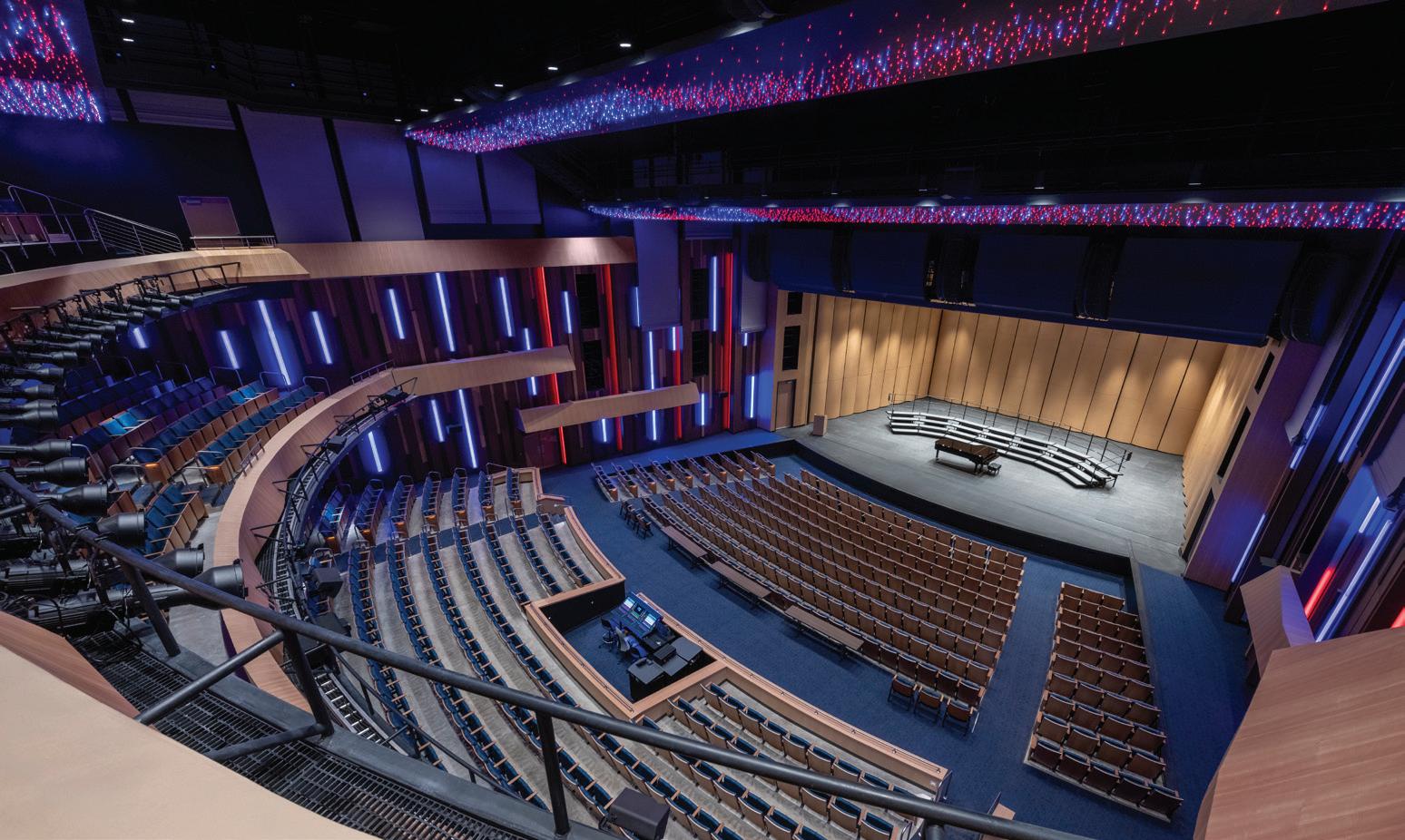
for a construction project, but once completed, the buildings will remain in use long after those administrators have moved on. So schools need to embrace a forward-thinking approach to designing a space that can be used for a wide range of activities with flexibility in an otherwise rigid and challenging architectural context.
Even today, new occupations emerging within the field of performing arts call for specific accommodations in event center design. Esports, for

Simply the Best



Sustainable, Campus-Wide Waste Solutions





Trash and recycling bins from Landmark are the waste management solution your campus needs. They do more than help simplify waste collection—they also improve your sustainability initiatives while enabling you to tailor each one to your specific campus. Our bins are:
• Made from a minimum 71 percent recycled materials
• Durable against all weather conditions
• Fully customizable sizes, designs, colors, and more
1-888-839-3853 LandmarkStudio.com
Scan to start customizing—and tell your Landmark Account Manager you saw this ad in AMERICAN SCHOOL & UNIVERSITY MAGAZINE 2406ASU_LandmarkStudio.indd 1 5/9/24 9:34 AM MAY/JUNE 2024 • ASUMAG.COM • AMERICAN SCHOOL & UNIVERSITY 23
The Visual & Performing Arts Center in the Cypress-Fairbanks (Texas) district was designed with flexibility to adapt to future needs.
The 85,000-square-foot Cypress-Fairbanks district’s Visual & Performing Arts Center was built at a cost of $51.5 million. When designing performing arts facilities, schools should employ a forward-thinking, flexible approach and create spaces that can be used for a wide range of activities.


instance, is an increasingly viable profession in our technological age, and new opportunities are continually developing.
Consequently, educators are looking for ways to design spaces flexible enough to accommodate something such as esports competitions or other emerging career paths. For students, a flexible space enables them to leverage their school experiences to gain a foothold in the professional esports space. Their time at school may translate directly into real-world experiences and opportunities.








For schools, a flexible space means thinking outside the box about which events constitute valuable educational experiences for students. Whether it’s an esports setup or an art gallery for student paintings, careful design enables schools to showcase and hone their students’ skills.
Ensuring that a space can anticipate the needs of the future requires careful planning. Any future remodeling that requires structural or invasive infrastructure changes will be costly and inefficient for schools. However, running cables, pulling wire, or swapping out projectors are examples of simple upgrades. When designing an adaptable space, consider how decisions made now can most easily tee up future iterations; that will save schools significant resources in the years to come as facilities need to adapt.
Performing arts centers have evolved from centering on a stage to creating an immersive experience for attendees. As the industry invests more heavily in technological advancements, elements to consider include video images, surround sound and even changing wall planes or ceiling features. Designing a space that can accommodate and even enhance these effects enables students to gain a more accurate understanding of how to develop a top-tier performance in a technology-driven world.
Keeping it cost-effective
Even as technology drives the industry, it raises a host of questions for schools seeking to provide cutting-edge technology while also making wise budgetary choices. A significant percentage of an event center’s budget goes into expenses such as control boards, rigging, lighting and audiovisual equipment. Because technology is constantly evolving, buildings must be designed to adapt as needed to suit a wide range of technologies and ensure that future upgrades are a low-stress and low-cost endeavor.
I 2311ASU_EvergreenTelemetry.indd 1 10/5/23 11:16 AM
24 AMERICAN SCHOOL & UNIVERSITY • ASUMAG.COM • MAY/JUNE 2024 ■ feature
The right equipment can save schools considerable resources while also serving as a force multiplier within a space. For example, portable and adjustable acoustical products enable a space to be used for a full orchestra one day and a single soloist the next without damaging the acoustical quality. Or, a building might be designed to meet the requirements for hosting competitions as well as performances, so that attendees and students alike can experience a broader range of activities. This type of flexibility is central to an effective, low-cost space that fulfills a school’s mission of serving all students and its surrounding community.
Additionally, planning carefully for the most responsible use of every square foot is a must for the cost-effective design of specialty buildings such as a performing arts center. Rather than simply looking at a two-dimensional rendition of a floor plan, consider the volume of the spaces. Creating storage space underneath a stage, for instance, enables schools to get greater value from the same floor plan.
Steps such as tracking the circulation of people and studying the geometry of a space are key to maximizing a facility’s potential. Total volume and relationships of volumetrically demanding spaces must be balanced along with the common approach of managing efficiency through gross and net square footage control.
Collaborating across teams
Partnering with the individuals who will manage operations or run events for a facility enables architects to create spaces that truly meet a school’s specific needs. Involving professionals with experience maintaining and using these facilities is a great way to anticipate and address future needs or concerns. Collaborating with experts across industries—such as technology or acoustics—also produces a more cohesive and effective building.
Schools are the heart of their communities. Although school buildings are designed primarily to serve students, they also have the opportunity to serve as a hub for community culture. Creating a space where other artists can come to perform helps solidify schools as a core part of the community. As more school buildings are being used as community resources in emergencies, school facilities are increasingly designed to serve all, and performing arts centers are no exception.
Putting students first requires careful planning for constant change and flexibility. Industries aren’t static, and their educational paths shouldn’t be either. Designing flexible spaces that help students prepare for their careers—whether that be in an orchestra or a gaming chair—is a powerful opportunity for schools to shape the lives and livelihoods of future generations.

energy
Kalwall leads the fenestration industr y in high per formanc e daylighting, with superior u-values and fantastic s olar heat gain c ontrol O ur transluc ent panels deliver per fec t daylighting for c ompetitive s pac es, ensuring high visual ac uit y and glare -free environments for peak per formanc e for athletes and s pec tator s alike
Controlled daylighting in buil dings is proven to pay bac k in more than just elec tric al and c ooling c osts, promoting human health an d reduc ing c ar b on footprint. That ’s good for b oth your bills and the environment
For nearly 70 year s, Kalwall has led the dif fuse daylighting revolution with high per formanc e transluc ent buil ding systems O ur produc ts are utilized in over 10 0 0+ LEED - c er tified an d Zero Energy Buil dings O ur c omplimentar y daylight modeling ser vic e and c omp osites tec hnology is unrivaled and no other c ompany in the worl d has dedic ated more year s, res ourc es, c reativit y and innovation into the s c ienc e and ar t of sustainable daylighting The proof is in the per formanc e
Brandon Ross, AIA, LEED AP, is the managing partner, Texas, at PBK, an architectural and engineering design solutions firm.
Facades | Skyroofs® | Skylights | Canopies kalwall.com
excellence
2406ASU_Kalwall.indd 1 4/2/24 9:03 AM MAY/JUNE 2024 • ASUMAG.COM • AMERICAN SCHOOL & UNIVERSITY 25
photo: GMC + Sherman Construction
 By Paul Erickson
By Paul Erickson
Stakeholder Involvement in Planning and Design
Involving stakeholders is essential for successful facilities planning and design—especially when managing various diverse groups, cultural expectations, and special interests. Determine who the stakeholders are, why they need to be involved, what they bring to the process, and how to manage their involvement.
Who and Why…
Who are the stakeholders? For a long-range facilities plan (LRFP), a bond referendum, and facility design, stakeholders may include parents, students, school board members, businesses, governmental agencies, and school district staff. Their involvement may provide insights about educational vision and standards, facilities conditions and needs, and community-use opportunities. They can enhance decision-making by taking part in focus groups, or forming liaisons with community organizations or governmental agencies.
What…
What value do stakeholders bring? For the LRFP, a facilities community task force may provide insights and come up with solutions that not only support student learning, but also meet community needs, support program flexibility, maintain a building’s useful life and fit within financial parameters.
A bond referendum becomes energized through community support. Community stakeholders serve on a campaign committee. The committee creates branding and consistent messaging to the public; it provides key information to the community, initiates communications, and facilitates interaction with news media.
For a facility design, a committee is formed with stakeholders—and they seek to identify learning needs, building operational requirements, and community expectations.
Managing Involvement
Stakeholder involvement occurs on multiple platforms via traditional and digital communication strategies. Interactive media makes it possible for more to participate.
For an LRFP, forming a community task force
gives stakeholders opportunities to be heard. Its responsibilities may include evaluating facilities data, analyzing and prioritizing user needs, aligning facilities to support curricula and exploring long-range facilities designs.
Choose key communicators from the community for the task force; choose members for a balance of expertise. Group consensus occurs when, after exploration and analysis, each member honestly says, “I understand your point of view, believe that you understand mine, and whether or not I prefer this decision I support it because it was arrived at openly through transparent dialogue and is the best solution according to the group at this time.”
Encourage task force stakeholders to lean toward action—avoid analysis-paralysis and over-thinking. For a bond campaign after LRFP work, encourage community stakeholders to conduct a survey to reflect on what should be included in a proposal. Form a community-based campaign committee to engage stakeholders. Use presentations, open houses, local publications, websites, and events as vehicles for voter engagement.
For facility design, form a committee and use focus groups for stakeholder engagement. This format emphasizes collaboration and sharing information. Responsibilities may include collecting data from tours of similar projects, critiquing design concepts, selecting materials and systems, and receiving building construction updates. Architects and engineers use REVIT-BIM technology so that stakeholders may experience three-dimensional visualizations of designs. This technology also enables facilities personnel to engage in managing facility maintenance, furniture selection, life-safety plans, and mechanical and electrical controls.
Opportunities for stakeholder involvement occur throughout planning and design processes. Adopt these ideas for engagement to achieve a successful outcome on your next LRFP, bond referendum, and building design.
Paul Erickson , AIA/NCARB/REFP, executive officer and partner, is past president of ATSR Planners/Architects/ Engineers. He has 45 years of experience in school planning, design, and construction. Erickson can be reached at perickson@atsr.com .
■ facility planning 26 AMERICAN SCHOOL & UNIVERSITY • ASUMAG.COM • MAY/JUNE 2024





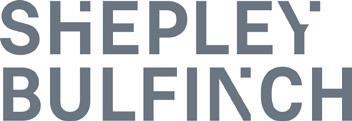




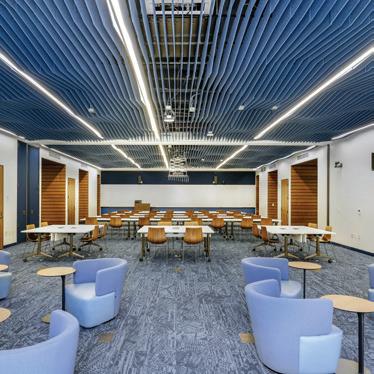
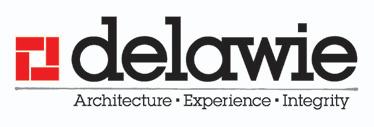


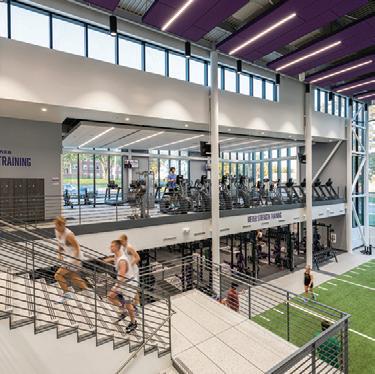








THE BRANCH SCHOOL, HIGHTOWER MIDDLE SCHOOL CORNELL COLLEGE RICHARD AND NORMA SMALL ATHLETIC AND WELLNESS CENTER VANCOUVER COMMUNITY COLLEGE CENTRE FOR CLEAN ENERGY AND AUTOMOTIVE INNOVATION OAKLAND UNIVERSITY VARNER HALL JANUARY AUGUST JULY ROCHESTER PREP HIGH SCHOOL WAREHAM ELEMENTARY SCHOOL FEBRUARY SEPTEMBER MARCH OCTOBER APRIL DECEMBER NOVEMBER MAY JACKSON PREP LOWER SCHOOL COTTRELL ELEMENTARY SCHOOL INDIAN LAND HIGH SCHOOL NORTHEASTERN UNIVERSITY- CHALOTTE, SCHOOL OF NURSING & HEALTH SCIENCES KNAUSS CENTER FOR BUSINESS EDUCATION JUNE Click, Print, Plan. 2024 Industry Events Calendar Free at SchoolDesigns.com. Visit SchoolDesigns.com today to print your complimentary copy of the 2024 American School & University/SchoolDesigns.com Calendar of Industry Events. Includes a detailed list of 2024 live and virtual conference and event dates. Plus a comprehensive directory of industry organizations with complete contact information. Each month showcases an outstanding school or university project. Visit SchoolDesigns.com to get your copy today! THE UNIVERSITY OF MARYLAND EASTERN SHORE SCHOOL OF PHARMACY AND HEALTH PROFESSIONS
Photo Credits—January: Slyworks Photography; February: Stantec Architecture; March: Feinknopf Photography/ Brad Feinknopf; April: Sully Clemmer; May: Tim Wilkes Photography; June: Gaffer Photography; July: Halkin Mason Photography LLC; August: Peter McCullough; September: Justin Maconochie Photography; October: Brett Beyer Photography; November: Karl. L Moore/ Mooreshots LLC; December: Peter Brentlinger
www.asumag.com www.schooldesigns.com
Reprints
To purchase custom reprints or e-prints of articles appearing in this publication contact reprints@endeavorb2b.com.
Archives & Microform
This magazine is available for research and retrieval of selected archived articles from leading electronic databases and online search services, including Factiva, Lexis-Nexis and Proquest.
Privacy Policy
Your privacy is a priority to us. For a detailed policy statement about privacy and information dissemination practices related to Endeavor Business Media products, please visit our website at endeavorbusinessmedia.com.
ProTeam’s GoFit® 3 / 6 Cordless Series
Emerson has introduced ProTeam’s GoFit 3 / 6 Cordless Series backpack vacuum cleaners. The 3- and 6-quart cordless vacuums combine the comfort of a lighter-weight profile with the cord-free convenience of advanced Lithium-ion battery power. The vacuums provide high-efficiency cleaning and come equipped with ProTeam’s advanced filtration and ergonomic quick-adjust harness system. Because it has no cords, there are no tripping hazards for users or pedestrians in high-traffic areas or stairways. The 4Ah battery runs about 51 minutes on low or 39 minutes on high, and the 8Ah battery runs about 106 minutes on low or 83 minutes on high.
https://proteam.emerson.com/en-us/proteam-advantage/gocordless
Smarter bottle filling stations from Zurn Elkay
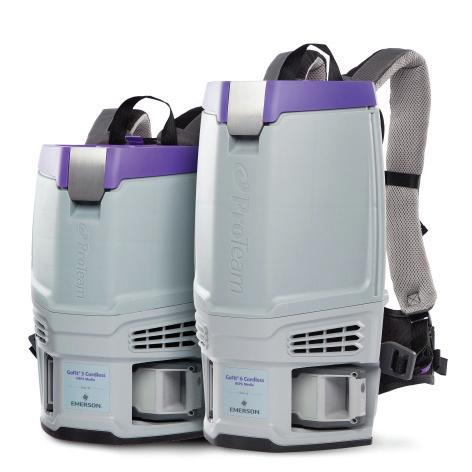
Zurn Elkay Water Solutions has launched an extension to its ezH2O® Bottle Filling Station line. Now, the ezH2O units have been made smarter. The connected units offer fresh, filtered water while letting facility managers track stats across every unit. The units are ideal for large offices, airports, colleges and public facilities. Campuses and large complexes can track bottles saved, filter status and water usage, and schedule flushing events to help keep lines cleaner. Some enhanced units also have a quick filter-change wrapper for easy access to the filter.
https://www.elkay.com/us/en/drinking-water/bottle-filling-stations.html
KIRA B 50 automatic scrubber from Kärcher
Kärcher’s newest autonomous cleaning machine is the KIRA B 50 scrubber. Threedimensional sensing along with integrated laser scanners ensures reliable, consistent navigation. An optional docking station and lithium-ion batteries enable KIRA B 50 to perform rapid, autonomous resource exchanges. With a working width of 22 inches, a maximum working speed of 2.7 mph and a powerful 160 Ah lithiumion battery, the scrubber brings an area performance of up to 25,450 sq. ft./hr in autonomous mode. KIRA B 50 is an ideal addition to applications such as logistics, transportation, retail, manufacturing, health care and education.


https://www.kaercher.com/us/commercial/autonomous-cleaning-equipment/kira-b-50-15330020.html
Aluflam’s True Aluminum Framing with new CONTRAFLAM® One glass
Joe Agron
Director of Sales
Buildings & Construction Group 941-200-4778
jagron@asumag.com
Brian Sack
Account Manager East & Northeast 732-629-1949
bsack@endeavorb2b.com
Randy Jeter
Account Manager South 512-263-7280
rjeter@endeavorb2b.com
Bill Boyadjis
Account Manager Midwest 973-829-0648
bboyadjis@endeavorb2b.com
Ellyn Fishman
Account Manager West 949-239-6030
efishman@endeavorb2b.com
Steve Suarez
Account Manager 816-588-7372
ssuarez@endeavorb2b.com
Aluflam North America has announced a significant advancement in its true aluminum framing system. Using Ventrotech’s groundbreaking CONTRAFLAM® One glass, Aluflam can now provide substantially larger openings in its fire-rated storefront and curtainwall systems. This opens up new possibilities for projects to feature bigger windows and brighter, more inviting interiors. Employing the fire-resistive glass technology, architects and designers can take advantage of the highest visible light transmittance, a broader range of temperature resistance, significant weight savings, and up to 35% less embedded carbon than the previous generation of Contraflam.
https://www.aluflam-usa.com/curtain-walls/
New phenolic lockers from Bradley


Bradley Company has introduced a collection of phenolic lockers designed to enhance style, maintenance and storage customization options. Durable and water- and moisture-resistant, the lockers stand up well to wet environments, heavy use and tough conditions. The lockers’ resistance to moisture helps prevent the growth of mold and mildew, and a smooth nonporous finish ensures a hygienic, easy-to-clean and low-maintenance solution. The resiliency of solid core phenolic lockers makes them perfect for high-traffic and moisture-prone applications. A variety of lockers, Z-lockers, cubby lockers and pedestal benches are available in a range of sizes, tiers, and colors.
https://www.bradleycorp.com/phenoliclockers.
FlexCourt indoor pickleball surface
Ecore has introduced FlexCourt, a portable, comfortable, high-performance indoor pickleball surface. FlexCourt features an 8mm vulcanized composition rubber base layer and is ideal for a range of facilities, from fitness clubs and gyms to convention centers. The court consists of interlocking tiles that can create a temporary or permanent pickleball court installation. Tiles are offered in two sizes: standard/regulation and a mini option for tighter spaces or portable play. The high-performance surface is engineered for heavy foot traction and remarkable speed with a high ball rebound rating for consistent, high-quality play.
https://www.ecoreintl.com/products/rubber/flexcourt

■ product solutions
28 AMERICAN SCHOOL & UNIVERSITY • ASUMAG.COM • MAY/JUNE 2024
Array air quality system from Fellowes

Fellowes’ Array™ air quality system for higher education campuses offers innovative networked technology and advanced air cleaning capabilities that enable colleges and universities to form complete, integrated and scalable networks for healthful air. Most commercial HVAC systems aim to meet the MERV 13 standard of filtration, but Array’s H13 True HEPA filters are twice as effective without compromising efficiency. The innovative design pulls contaminants out of the breathing zone and pushes clean air into a room to improve ventilation effectiveness.
www.fellowes.com/us/en/catalog/air-quality-management/ industries/pg/higher-education
Solar benches from Bluebolt Outdoor

Bluebolt Outdoor LLC has installed solar-powered benches on the campus of California State University, Dominguez Hills. Provided to the university at no cost, the benches offer a convenient place to rest that is equipped with device-charging capabilities, all powered by the sun. “The Bench” operates entirely off the grid, relying on solar power stored in a lithium battery within the unit. This configuration allows for device charging and additional campus lighting in the evening, with enough stored power to last up to five days. Each bench features two backlit advertising panels. Bluebolt has planned installations at more campuses this summer. https://blueboltoutdoor.com/
Airius introduces Onyx 560 fans

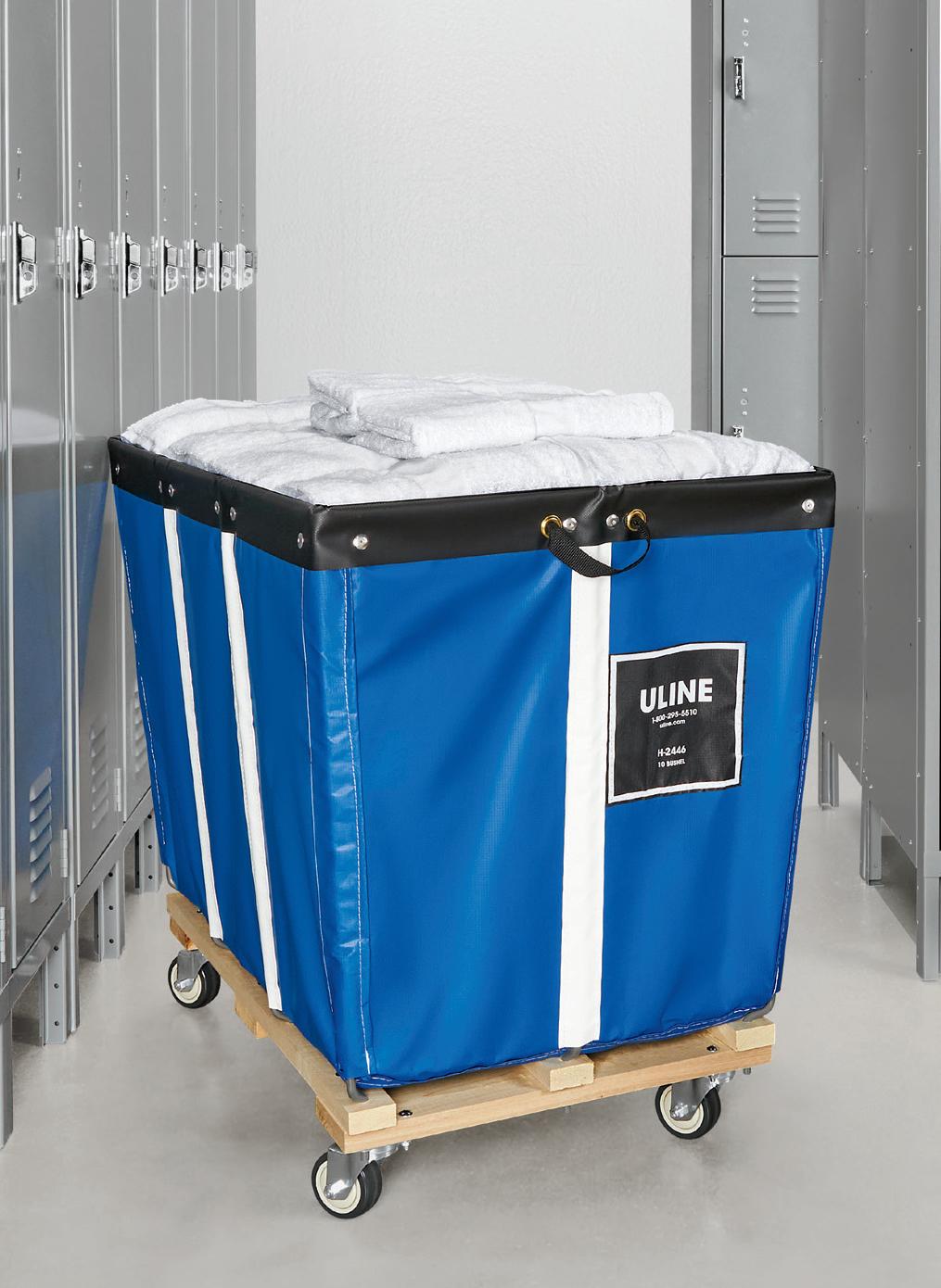
Airius has introduced the newest and largest addition to its Onyx Series of fans. The Onyx 560 is engineered to provide outstanding cooling and air mixing for a comfortable and consistent indoor environment. With a significantly longer air throw than traditional ceiling fans, the fan is a great alternative to high-volume, low-speed (HVLS) fans. The Onyx 560’s innovative design facilitates installation in locations inaccessible to HVLS ceiling fans. Designed with an aluminum enclosure and EC motor technology, the Onyx 560 will integrate into existing infrastructures or new construction projects. http://airiusfans.com/onyx
Lupa luminaires from Cyclone Lighting

Cyclone Lighting, a manufacturer of outdoor luminaires, has introduced its Lupa luminaire. Lupa features a disk shape, no visible hardware, and a seamlessly integrated arm to bring a contemporary feel and refined look to public spaces. It is intended for urban landscapes such as parks, courtyards, and university campuses. Lupa was designed with lower pole heights to contribute to a feeling of security. Yet, its light engine produces a gentler, more comfortable gradient for a softer look and glare-free environment. Lupa’s light engine also features the latest ink technology in its diffuser to deliver broader, more even light distribution. www.cyclonelighting.com







MAY/JUNE 2024 • ASUMAG.COM • AMERICAN SCHOOL & UNIVERSITY 29 Aerator Let the exceptional beauty of the MIKADO inspire and distinguish you. With its distinctive spray pattern, the MIKADO creates a pleasantly soft stream. Now available in 0.35, 0.5, 1.0, and 1.2 gpm. Neoperl, Inc. Waterbury, CT us.info@neoperl.com www.neoperl.us 2406ASU_Neoperl.indd 1 4/3/24 2:51 PM COMPLETE CATALOG 1-800-295-5510 π LOCKER ROOM MUST-HAVES BASKET TRUCKS ORDER BY 6 PM FOR SAME DAY SHIPPING 2406ASU_Uline.indd 1 5/2/24 9:23 AM
WHERE FACILITY CHALLENGES FIND SOLUTIONS
NORTHERNCALIFORNIA
August 21-22, 2024
Reno, NV NORTH TEXAS
October 29-30, 2024
Irving, TX
October 9-10, 2024
Santa Clara, CA


























O W N E D & P R O D U C E D BY: facilitiesexpo.com
RENO


Earn AIA continuing education (CE) credits through our online courses and webinars, designed to help you advance your skills and maintain your professional credentials with ease. Learn at your own pace and on your own schedule, with on-demand access to our educational content anytime, anywhere and earn LU|Elective and LU|HSW credits in the process. See more CEU courses at https://archdesignmaster.com/



How Architectural Finishes
Create a Total Transformation
3M™ DI-NOC™ Architectural Finishes enable owners to create the look they want in their building – at a fraction of the cost.
AIA Credits: 1 LU
Color Theory Helps Explain Our Relationship to Nature and Wellbeing
This CEU explores people’s interactions, effects and perceptions of color and its impact on wellbeing.
AIA Credits: 1 LU/HSW


Credits Approved by: CEUs Powered by:

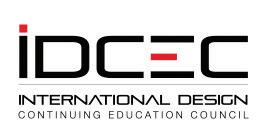

Lessons in Renovation and Adaptive Reuse
Discover solutions for improving acoustics, bringing daylight deeper into the floorplate, and improving energy performance with interior and exterior products.
AIA Credits: 1 LU/HSW
Best
Practices
for Building Energy Management
This course is on the basics of realizing deep savings on building systems such as lighting, HVAC, building automation.
AIA Credits: 1 LU



Earn AIA credits for free today!

SELF-PACED CONTINUING
EDUCATION












Showcase your insights, leadership, projects, and more. > A full color page devoted to your company > You choose three questions and answers to showcase your expertise > Three images of your leadership and/or your work > Company logo > Contact information > Great for architectural firms, interior designers, and design and building professionals who work with schools or universities > Discounts for design competition entrants Contact Heather Buzzard at hbuzzard@asumag.com for more information. Reserve a Q&A page in the AUGUST 2024 Educational Interiors Showcase 2406ASU_House_Q&A.indd 1 5/6/24 1:12 PM MORRISGROUPINT.COM Hydration is a reach away. Find Your Lifestyle at murdockmfg.com 2402ASU_MorrisGroupInternational_MKPL.indd 1 1/10/24 3:28 PM ADVERTISER PAGE 2024 Industry Events Calendar 27 Aiphone Communications Systems 15 Architectural Portfolio 21 Architecture+Design Master Continuing Education 31 Armstrong World Industries 9, 33 Bradley Corp. 13, 33 Carrier Corp. 11 Daikin Comfort Technologies 7 Educational Interiors Showcase 32 Evergreen Telemetry 24 Facilities Expo 2024 30 Kaivac 5 Kalwall Corp. 25, 33 Karcher North America, Inc. IFC Landmark Studio 23 Morris Group International 19, 32 NeoCon 2024 IBC Neoperl, Inc. 29 Protect-All Flooring 18, 33 Roppe Corp. 3 The HON Company BC Uline 29 This index is a service to our reader. Every effort is made to maintain accuracy, but American School & University cannot assume responsible for errors or omissions. AD INDEX MARKETPLACE 32 AMERICAN SCHOOL & UNIVERSITY • ASUMAG.COM • MAY/JUNE 2024


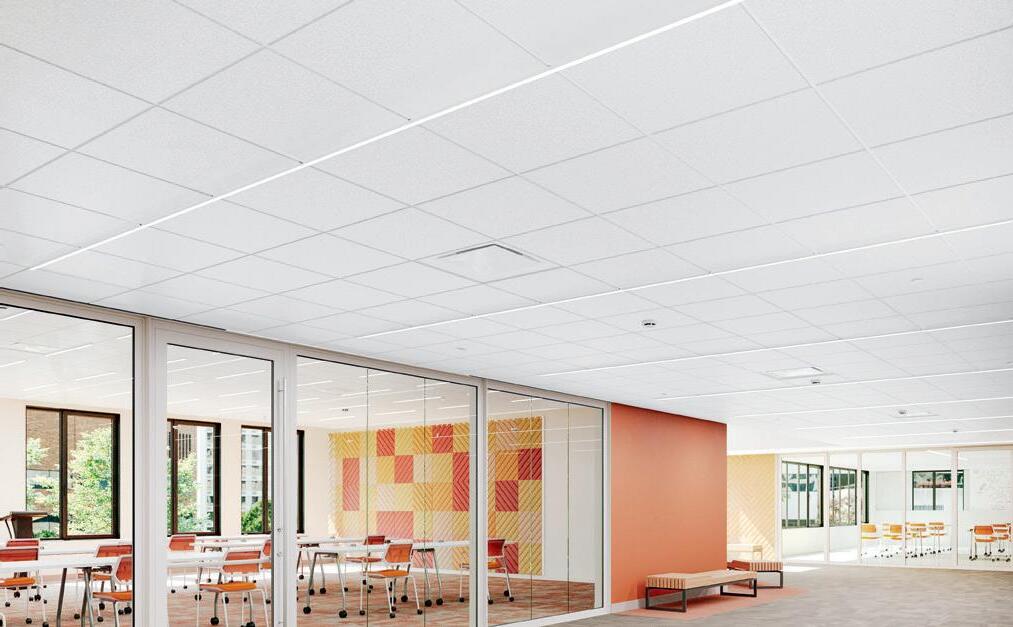

Templok® Energy Saving Ceilings can reduce your
HVAC energy costs and consumption up to 15%* and enhance thermal comfort with advanced Phase Change Material technology. The panels deliver Total Acoustics® performance for the highest sound blocking and sound absorption. Start saving today at armstrongceilings.com/energysavingceilings










Ceilings designed to save energy
*Measured cooling energy savings in lab test. Results may vary. See Templok Technical Guide for details. 2406ASU_Armstrong_MKPL.indd 1 5/10/24 9:07 AM + per formance + balance + sustainabilit y + wellness + ef ficiency + safet y kalwall.com 2406ASU_Kalwall_MKPL.indd 1 4/2/24 1:11 PM Enhance the aesthetics and performance of your next flooring project. Visit protect-allflooring.com or call 800.544.9538 OP P -A D g S Ad - OP 4000 O g 1 30 0 REV 10 21 P ote -A and Pro ec -A Des gner Ser e a e eg s ered adema k owned by Oscoda P as c nc Heavy-duty can now be stunning or DURABILITY DesignerMEETS NEW COLORS BLACK BASE 2306ASU_ProtectAllFlooring_MKPL.indd 1 5/24/23 12:43 PM HANDWASHING
Bradley’s Express® TLX Series 4-station Lavatory System. bradleycorp com/express-lavatory-systems 2406ASU_Bradley_MKPL.indd 1 5/7/24 1:05 PM MARKETPLACE MAY/JUNE 2024 • ASUMAG.COM • AMERICAN SCHOOL & UNIVERSITY 33
school’s
POWERHOUSE
Surprise retirement leads to new superintendent in Broward County (Florida) district
Broward County (Florida) School Superintendent Peter Licata has been replaced immediately after he told the school board he wanted to retire at the end of the year because of health concerns.
The Miami Herald reports that Howard Hepburn, who has been Broward County’s deputy superintendent for teaching and learning, was promoted to superintendent after Licata’s announcement. Broward County is the nation’s sixth-largest school district with more than 250,000 students.
Licata, who had been superintendent less than a year, took the school board by surprise in April when he disclosed that he wanted to retire Dec. 31 over health reasons.
In response, the school board voted 8-1 to separate from Licata immediately, instead of waiting until December. The board also voted 8-1 to name Hepburn as the new superintendent.
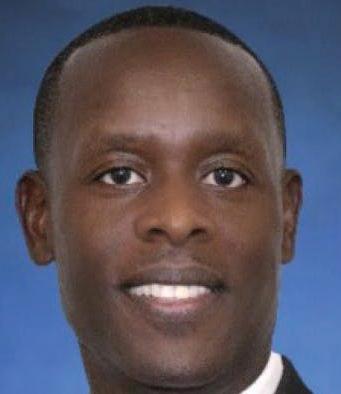
Hepburn is Broward’s fourth superintendent since 2021.
DeKalb County (Georgia) board agrees to pay $325,000 to superintendent it fired
The DeKalb County (Georgia) School Board has agreed to pay $325,000 to settle the contract of the superintendent it fired in 2022 after less than two years on the job.
WSB-TV reports that the board voted 6 to 1 to approve the settlement with Cheryl WatsonHarris based on her original contract terms. The board also agreed to pay $16,000 in attorneys fees.

At the time of her firing, Watson-Harris said she was “blindsided” by her the board’s action, but board members said their relationship had been “deteriorating for some time to the point the association became irreconcilable.”
Watson-Harris was named superintendent for DeKalb Schools in June 2020.
Before being hired in DeKalb County, Watson-Harris served as first deputy chancellor, senior director of field support and Brooklyn executive director for the New York City Department of Education.
Court of Appeals order keeps demolition of 104-year-old school building on hold
The Michigan Court of Appeals has issued an order that continues to block the West Bloomfield School District from demolishing a century-old former elementary school.
The Detroit News reports that order from the three-judge panel gives a group of Oakland County activists more time to file appeals and preserve the 104-year-old Roosevelt Elementary School in Keego Harbor.

The district had wanted to begin demolition preparations in
April; it had scheduled demolition of the 70,000-square-foot building for June.
The former Roosevelt Elementary has been an anchor for the 2,700-resident Oakland County community of Keego Harbor, supporters assert. The building sits adjacent to the local police station and City Hall.
The school was closed in 2022 and its students were moved to another building in the West Bloomfield district. In calling for demolition, officials have said the shuttered school building is unsafe for students and costly to maintain.
Poway (California) school board fires superintendent
The Poway (California) school board has voted to fire Superintendent Marian Kim Phelps.
The San Diego Union-Tribune reports that the dismissal follows an investigation into the softball program at Del Norte High School in San Diego and accusations that Phelps harassed its players after an end-of-season awards banquet last year.
“Based on her conduct, as revealed to the board through the investigation, the board has lost all confidence and trust in Dr. Phelps’ ability to continue to serve as superintendent, as well as in her ability to continue to work collaboratively with the board as part of Poway Unified’s governance team,” said Board President Michelle O’Connor-Ratcliff.
Phelps had been superintendent of the 36,000-student district since April 2017.
During the past year, softball players, parents and coaches have alleged that Phelps had harassed members of the Del Norte softball team because she believed they didn’t clap loudly enough for her daughter, Jessica Phelps, a pitcher on the team, at the banquet.
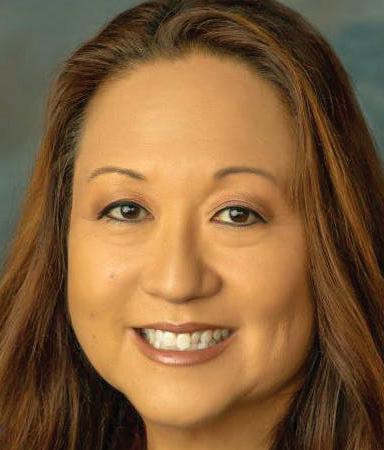
In November, a Poway Unified high school senior softball player sued the district and its leaders, accusing Phelps of pursuing a campaign of punishment and harassment against her and her teammates.
Phelps denied the allegations and said her daughter was being bullied by another Del Norte student before and after the banquet.
■ profiles | people, places & goings-on in education facilities & businesses
34 AMERICAN SCHOOL & UNIVERSITY • ASUMAG.COM • MAY/JUNE 2024
Poway Unified School District
Google
DeKalb County School District
Broward County Public Schools



Design Takes Shape
June 10–12 2024









MART
neocon.com NeoCon ® is a registered trademark of Merchandise Mart Properties, Inc.
THE
Chicago



Make your space work® Every solution we craft helps create flexible environments that support all levels of learning, collaboration, and creativity. Learn more on hon.com/Education > Expanding the Potential for Learning

















































































































































 By Paul Erickson
By Paul Erickson























































































































